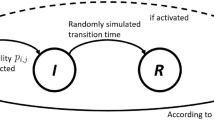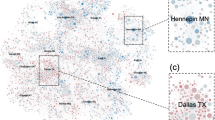Abstract
Information about the vaccine is usually spread through heterogeneous networks in reality, where public opinion bursts out faster than in homogeneous networks. Considering the complexity of heterogeneous networks, we develop a network susceptible-forwarding-immune (NET-SFI) model to describe the patterns of information propagation in the actual social network. Classifying the states of nodes according to the number of users can contact in the social network, the NET-SFI model focuses on the network structure and user heterogeneity. We adopt a data-model drive method to conduct the model validation including two types of COVID-19 vaccine information from the Chinese Sina Microblog. Our parameter sensitivity analyses show the important significance of node degree in causing the outbreak of public opinion. Moreover, corresponding conclusions based on our analytic study are conducive to designing valid strategies for vaccine information dissemination.









Similar content being viewed by others
Explore related subjects
Discover the latest articles and news from researchers in related subjects, suggested using machine learning.References
Abbas UL, Anderson RM, Mellors JW (2007) Potential impact of antiretroviral chemoprophylaxis on HIV-1 transmission in resource-limited settings. PLoS ONE 2(9):e875
Ally AF, Zhang N (2018) Effects of rewiring strategies on information spreading in complex dynamic networks. Commun Nonlinear Sci Numer Simul 57:97–110
Chatterjee S, Hadi AS (2013) Regression analysis by example. John Wiley & Sons
Chen FH (2006) A susceptible-infected epidemic model with voluntary vaccinations. J Math Biol 53(2):253–272
Chen T, Shi J, Yang J et al (2020) Modeling public opinion polarization in group behavior by integrating SIRS-based information diffusion process. Complexity 2020:4791527
Chen T, Yin X, Yang J et al (2021) Modeling multi-dimensional public opinion process based on complex network dynamics model in the context of derived topics. Axioms 10(4):270–302
Dietz K (1967) Epidemics and rumours: a survey. J R Stat Soc: Ser A (gen) 130(4):505–528
Fu M, Feng J, Lande D et al (2021) Dynamic model with super spreaders and lurker users for preferential information propagation analysis. Physica A 561:125266
Galam S (2003) Modelling rumors: the no plane Pentagon French hoax case. Physica A 320:571–580
Gao Q, Abel F, Houben GJ, Yu Y (2012) A comparative study of users’ microblogging behavior on Sina Weibo and Twitter[C]. In: Modeling U (ed) Adaptation, and personalization: 20th international conference (UMAP). Springer, Berlin, Heidelberg, pp 88–101
Goffman W, Newill V (1964) Generalization of epidemic theory. Nature 204(4955):225–228
Hosni AIE, Li K, Ahmad S (2020) Minimizing rumor influence in multiplex online social networks based on human individual and social behaviors. Inf Sci 512:1458–1480
Kermack WO, McKendrick AG (1991) Contributions to the mathematical theory of epidemics—I 1927. Bull Math Biol 53(1–2):33–55
Lahrouz A, Omari L, Kiouach D et al (2012) Complete global stability for an SIRS epidemic model with generalized non-linear incidence and vaccination. Appl Math Comput 218(11):6519–6525
Li MY, Muldowney JS (1995) Global stability for the SEIR model in epidemiology. Math Biosci 125(2):155–164
Lu Z, Gao S, Chen L (2003) Analysis of an SI epidemic model with nonlinear transmission and stage structure. Acta Mathematica Scientia 23(4):440–446
Luarn P, Yang JC, Chiu YP (2014) The network effect on information dissemination on social network sites. Comput Hum Behav 37:1–8
Ma J, Zhu H (2018) Rumor diffusion in heterogeneous networks by considering the individuals’ subjective judgment and diverse characteristics. Physica A 499:276–287
Moreno Y, Nekovee M, Pacheco AF (2004) Dynamics of rumor spreading in complex networks. Phys Rev E 69(6):066130
Pastor-Satorras R, Vespignani A (2001) Epidemic spreading in scale-free networks. Phys Rev Lett 86(14):3200
Pastor-Satorras R, Vespignani A (2004) Evolution and structure of the Internet: a statistical physics approach. Cambridge University Press
Rui X, Meng F, Wang Z et al (2018) SPIR: The potential spreaders involved SIR model for information diffusion in social networks. Physica A 506:254–269
Stone L, Shulgin B, Agur Z (2000) Theoretical examination of the pulse vaccination policy in the SIR epidemic model. Math Comput Model 31(4–5):207–215
Tang M, Mao X, Yang S, Zhou H (2014) A dynamic microblog network and information dissemination in “@” mode. Math Probl Eng 2014:1–15
Wang X, Li Y, Li J et al (2021a) A rumor reversal model of online health information during the Covid-19 epidemic. Inf Process Manage 58(6):102731
Wang Y, Wang J, Wang H et al (2021b) Users’ mobility enhances information diffusion in online social networks. Inf Sci 546:329–348
Yin F, Shao X, Wu J (2019) Nearcasting forwarding behaviors and information propagation in Chinese Sina-Microblog. Math Biosci Eng 16(5):5380–5394
Yin F, Zhu X, Shao X et al (2021) Modeling and quantifying the influence of opinion involving opinion leaders on delayed information propagation dynamics. Appl Math Lett 121:107356
Yu Z, Lu S, Wang D et al (2021) Modeling and analysis of rumor propagation in social networks. Inf Sci 580:857–873
Yuan J, Shi J, Wang J et al (2022) Modelling network public opinion polarization based on SIR model considering dynamic network structure. Alex Eng J 61(6):4557–4571
Zhang YX, Feng YX, Yang RQ (2019) Network public opinion propagation model based on the influence of media and interpersonal communication. Int J Mod Phys B 33(32):1950393
Zhang M, Qin S, Zhu X (2021) Information diffusion under public crisis in BA scale-free network based on SEIR model—Taking COVID-19 as an example. Physica A 571:125848
Zhao J, He H, Zhao X et al (2022) Modeling and simulation of microblog-based public health emergency-associated public opinion communication. Inf Process Manage 59(2):102846
Funding
The work was supported by the National Natural Science Foundation of China (No. 62372418); the Beijing Natural Science Foundation (No. 4232015); the State Key Laboratory of Media Convergence and Communication, Communication University of China; the Fundamental Research Funds for the Central Universities; the High-quality and Cutting-edge Disciplines Construction Project for Universities in Beijing (Internet Information, Communication University of China). JW was funded by the Natural Science and Engineering Research Council of Canada; and by the Canada Research Chair Program.
Author information
Authors and Affiliations
Corresponding authors
Additional information
Publisher's Note
Springer Nature remains neutral with regard to jurisdictional claims in published maps and institutional affiliations.
Rights and permissions
Springer Nature or its licensor (e.g. a society or other partner) holds exclusive rights to this article under a publishing agreement with the author(s) or other rightsholder(s); author self-archiving of the accepted manuscript version of this article is solely governed by the terms of such publishing agreement and applicable law.
About this article
Cite this article
Yin, F., Wang, J., Pang, H. et al. Modeling and analyzing network dynamics of COVID-19 vaccine information propagation in the Chinese Sina Microblog. Comput Math Organ Theory 31, 161–180 (2025). https://doi.org/10.1007/s10588-024-09386-x
Accepted:
Published:
Issue Date:
DOI: https://doi.org/10.1007/s10588-024-09386-x




